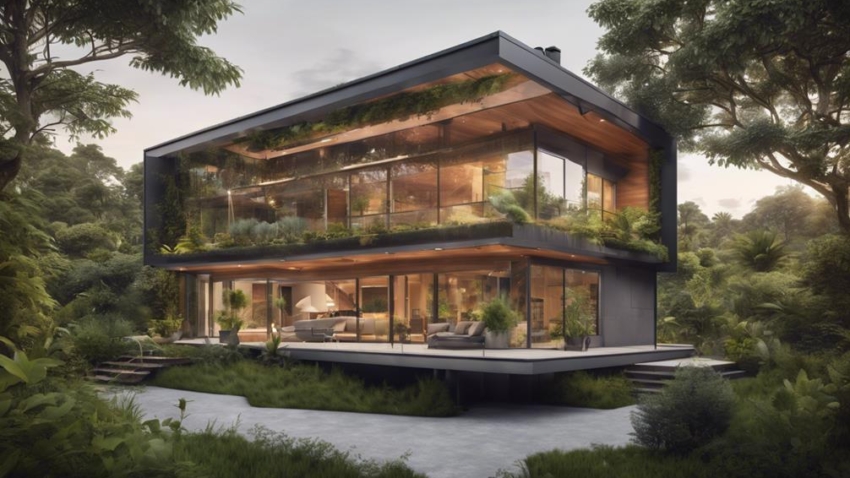
Eco-Friendly Homes: What to Know Before You Buy
When searching for an eco-friendly home, you'll encounter various certifications, features, and technologies that claim to reduce environmental impact. It's essential to understand what truly sets an eco-friendly home apart. You'll want to look for certifications like LEED, Energy Star, and Passive House, which guarantee rigorous environmental and energy efficiency standards. You'll also want to take into account energy-efficient features like double-glazed windows and solar panels, sustainable materials, and smart home technology integration. As you explore the world of eco-friendly homes, you'll discover more ways to reduce your carbon footprint and create a sustainable living space that's perfect for you – and the planet.
Understanding Eco-Friendly Certifications
When shopping for an eco-friendly home, start by looking for certifications like LEED, Energy Star, and Passive House, which guarantee that the property meets rigorous environmental and energy efficiency standards. These certifications confirm that your future home has been independently verified to be sustainable and energy-efficient.
As you explore eco-friendly properties, it's essential to understand what each certification means. LEED certification, for instance, focuses on sustainable construction practices and energy efficiency, ensuring that your home is built with the environment in mind. Energy Star certification, on the other hand, highlights energy-efficient appliances and systems in the home, reducing your carbon footprint.
Passive House certification takes energy efficiency to the next level, emphasizing a high level of energy efficiency and comfort. By choosing a home with one of these certifications, you can feel confident that you're not only reducing your environmental impact but also creating a healthier living space.
When searching for your eco-friendly home, keep an eye out for these certifications. They're your guarantee that the property has met rigorous environmental and energy efficiency standards, making your new home a haven for both you and the planet. By understanding the value of these certifications, you'll be well on your way to finding your perfect eco-friendly home.
Energy Efficiency Features to Look
As you search for your eco-friendly home, you'll want to keep an eye out for energy-efficient features that can save you money and reduce your carbon footprint. Two key features to look for are double-glazed windows, which can greatly reduce heat loss and energy consumption, and solar panel systems, which can generate clean energy and lower your utility bills. By prioritizing these energy-efficient features, you'll be well on your way to creating a sustainable and eco-friendly living space.
Double-Glazed Windows
By incorporating double-glazed windows into your eco-friendly home, you'll reap the benefits of improved energy efficiency, reduced noise pollution, and a more peaceful living space. These windows consist of two panes of glass with a layer of inert gas in between, providing better insulation and energy efficiency. As a result, you'll enjoy a warmer home in winter and a cooler one in summer, which translates to lower energy bills. The added insulation also helps reduce noise pollution from outside, creating a quieter and more peaceful indoor environment. Moreover, the insulating properties of double-glazed windows can help prevent condensation buildup, reducing the risk of mold and mildew growth. By investing in double-glazed windows, you'll not only increase the energy efficiency of your home but also contribute to a more sustainable and eco-friendly living space. With these benefits, you'll be able to enjoy a comfortable, peaceful, and environmentally friendly home that you can be proud to call your own.
Solar Panel Systems
You can greatly reduce your reliance on fossil fuels and lower your energy bills by incorporating solar panel systems into your eco-friendly home. With solar panels, you can reduce your energy bills by up to 70%, which is a significant cost savings over time. Plus, solar panels can increase your property value by up to $15,000, making your home more attractive to potential buyers if you decide to sell in the future.
As a renewable and sustainable energy source, solar energy is a great way to reduce your carbon footprint. In fact, a typical residential solar panel system can offset 178 tons of CO2 over 30 years, which is a huge benefit for the environment. While the initial cost of solar panels may seem challenging, the average payback period is around 7-20 years, making it a worthwhile investment in the long run. By choosing solar panels, you'll not only be reducing your energy bills, but you'll also be doing your part to reduce your reliance on fossil fuels and promote a cleaner, more sustainable future.
Sustainable Materials and Construction
As you explore eco-friendly homes, you'll want to focus on sustainable materials and construction methods that reduce environmental impact. When you're evaluating a property, look for green building materials like bamboo flooring, reclaimed wood, and recycled glass countertops that minimize waste and pollution. By choosing a home with energy-efficient design and sustainable construction, you'll not only reduce your carbon footprint but also create a healthier living space.
Green Building Materials
When it comes to constructing an eco-friendly home, selecting sustainable materials is essential, and options like bamboo flooring, reclaimed wood, and recycled glass countertops offer a great starting point. You'll be embracing sustainable living while reducing your carbon footprint. These green building materials are environmentally friendly and contribute to a more sustainable future. By choosing locally-sourced materials, you'll also minimize transport emissions, making your home even more eco-friendly.
As you design your dream home, prioritize environmentally friendly materials that promote sustainability. From the foundation to the finishes, every material choice counts. Consider reclaimed wood for its unique charm and reduced waste. Bamboo flooring is another excellent option, known for its durability and low environmental impact. Recycled glass countertops add a touch of elegance while reducing waste. By incorporating these sustainable materials, you'll be creating a haven that not only benefits you but also the planet. By making informed choices, you'll be part of the movement towards a more sustainable future.
Energy-Efficient Design
Energy-efficient design in eco-friendly homes relies on careful planning and strategic material selection to minimize energy consumption and reduce carbon emissions. As you explore eco-friendly homes, you'll notice that energy-efficient design is a top priority. This means incorporating low-energy fixtures and fittings to reduce energy consumption and carbon emissions. By doing so, you'll not only reduce your environmental footprint but also save on energy bills.
In an eco-friendly home, sustainable building materials are used to promote energy conservation and water efficiency. This includes using materials like bamboo flooring, reclaimed wood, and recycled glass countertops. These materials not only reduce waste but also minimize the environmental impact of construction. Green buildings aim to achieve net-zero or net-neutral carbon emissions, ensuring that your home has a minimal impact on the environment. By choosing an eco-friendly home with energy-efficient design, you'll be part of a community that values sustainability and reduces its environmental footprint.
Water Conservation and Recycling
By incorporating water-conserving features into your home, you can greatly reduce your water usage and lower your environmental footprint. One effective way to do this is by installing rainwater harvesting systems, which can collect and reuse water for irrigation and non-potable uses. Additionally, low-flow fixtures like faucets and toilets can reduce water consumption by up to 60%.
| Water Conservation Method | Benefits |
|---|---|
| Rainwater Harvesting Systems | Collects and reuses water for irrigation and non-potable uses |
| Low-Flow Fixtures | Reduces water consumption by up to 60% |
| Greywater Recycling Systems | Repurposes water from sinks and showers for secondary uses |
| Efficient Landscape Design | Minimizes water usage with native plants and drip irrigation |
Smart Home Technology Integration
As you step into your eco-friendly home, smart home technology integration seamlessly blends into your daily routine, empowering you to take control of your energy usage and make a significant impact on the environment. You'll appreciate the convenience of smart thermostats, lighting controls, and energy monitoring systems that work together to optimize energy efficiency. These innovative features enable you to monitor and adjust your energy consumption in real-time, reducing waste and lowering your utility bills.
With smart home technology, you can control your energy usage remotely, ensuring that your eco-friendly home remains efficient even when you're away. Imagine being able to adjust the temperature, turn off lights, or receive notifications about energy-hungry appliances, all from the palm of your hand. This level of control not only saves you money but also contributes to a more sustainable lifestyle.
Indoor Air Quality and Ventilation
How do you ensure the air you breathe in your eco-friendly home is as fresh and clean as the environment you're trying to preserve? The answer lies in proper ventilation and indoor air quality control. You might be surprised to learn that indoor air can be 2-5 times more polluted than outdoor air, which can lead to respiratory issues, allergies, and asthma. That's why it's important to prioritize ventilation in your eco-friendly home.
By investing in proper ventilation, you can reduce indoor pollutant levels by up to 50%. This means minimizing the amount of pollutants that can aggravate respiratory issues and negatively impact your overall well-being. Air purifiers can also play a significant role in removing up to 99.97% of indoor pollutants, ensuring the air you breathe is clean and fresh.
However, it's not just about removing pollutants; humidity control is also essential. When humidity levels are uncontrolled, it can lead to mold growth, which can exacerbate respiratory problems. By maintaining ideal humidity levels, you can prevent mold growth and create a healthier living environment.
Eco-Friendly Landscaping and Gardens
You can greatly reduce your eco-friendly home's environmental footprint by extending your sustainable practices to the outdoors through smart landscaping and gardening choices. By adopting eco-friendly landscaping, you can reduce water usage by up to 50% compared to traditional landscapes. One way to achieve this is by incorporating native plants into your garden, which require less maintenance and are more resistant to pests and diseases. This means you'll save time, money, and resources in the long run.
Another key aspect of eco-friendly landscaping is managing water runoff. Rain gardens, for instance, help reduce stormwater runoff and prevent erosion. You can also use permeable paving, which decreases water runoff and minimizes flooding. These features not only benefit the environment but also enhance the aesthetic appeal of your outdoor space.
In addition to these features, incorporating composting and mulching practices into your gardening routine promotes soil health and reduces waste. By composting organic matter, you'll create a nutrient-rich soil amendment that supports healthy plant growth. Mulching, on the other hand, helps retain moisture, suppress weeds, and regulate soil temperature. By embracing these eco-friendly landscaping and gardening practices, you'll create a sustainable and thriving outdoor space that complements your eco-friendly home.
Maintenance and Upkeep Requirements
Owning an eco-friendly home typically means enjoying lower maintenance costs, thanks to the durable and sustainable materials used in its construction. This is a significant advantage, as you'll spend less time and money on repairs and replacements. However, you'll still need to perform regular upkeep to guarantee your eco-friendly features continue to function at their best.
As a homeowner, you'll need to monitor your energy-efficient systems, such as solar panels or geothermal heating, to make sure they're working efficiently. This might involve routine inspections and occasional cleaning to keep them running smoothly. Additionally, your sustainable landscaping practices can reduce maintenance needs and promote eco-friendly living. By choosing low-maintenance plants and using rainwater harvesting systems, you'll spend less time tending to your outdoor space.
The level of technology and green features integrated into your home will influence your upkeep requirements. For instance, if you have a complex rainwater harvesting system, you'll need to perform more frequent inspections and maintenance tasks. On the other hand, if you have a simpler system, your upkeep tasks will be less frequent.
Budgeting for Eco-Friendly Upgrades
Considering the long-term savings and environmental benefits, budgeting for eco-friendly upgrades becomes an essential step in creating a sustainable and energy-efficient home. You'll want to prioritize your spending to maximize the impact of your upgrades. Here's a breakdown of the costs and benefits to take into account:
| Upgrade | Initial Cost | Annual Savings |
|---|---|---|
| Energy-Efficient Appliances | $1,000 – $3,000 | $600 |
| Solar Panels | $15,000 – $30,000 | $1,000 (plus federal tax credits) |
| Proper Insulation | $1,000 – $2,000 | 10% of heating/cooling costs |
| Water-Efficient Fixtures | $500 – $1,000 | 11,000 gallons of water/year |
| Eco-Friendly Materials | $500 – $2,000 | Improved indoor air quality |
As you budget for eco-friendly upgrades, remember that the initial costs can be offset by long-term savings and benefits. For example, energy-efficient appliances can save you up to $600 annually on utility bills. Similarly, investing in proper insulation can lead to a 10% reduction in heating and cooling costs. By choosing eco-friendly materials like bamboo flooring, you'll not only enhance indoor air quality but also reduce environmental impact. By prioritizing your budget and making smart upgrades, you can create a sustainable and energy-efficient home that benefits both you and the planet.
Frequently Asked Questions
What to Look for in an Eco-Friendly Home?
As you search for the perfect eco-friendly home, you'll want to look for green building certifications, like LEED or Energy Star. Prioritize properties with energy-efficient features like solar panels, high-efficiency appliances, and superior insulation. Don't forget to check for sustainable materials, water conservation systems, and natural lighting. Proper ventilation systems and insulation will guarantee a healthy, comfortable living space. By considering these factors, you'll find a home that's not only good for the planet, but also a haven for you and your loved ones.
What Is the Disadvantage of Eco Home?
As you weigh the benefits of eco-friendly living, consider the potential downsides. You may face higher maintenance costs for specialized systems, limited options in certain areas, and potentially higher taxes on your eco-friendly property. Additionally, you might encounter social stigma, limited resale value, higher insurance premiums, or local restrictions that hinder your eco-friendly lifestyle. It's essential to weigh these disadvantages against the benefits before making a decision.
Is It More Expensive to Build an Eco-Friendly House?
You're wondering if building an eco-friendly house breaks the bank. The short answer is yes, it can be more expensive upfront. You'll pay a "green premium" due to higher material prices and labor costs. However, you'll benefit from cost comparisons that show long-term savings on energy bills and maintenance. Plus, don't forget about financial incentives like tax credits and rebates that can offset the initial costs, helping you stay within your budget constraints and avoiding hidden expenses.
What Are 5 Things You Do at Home to Be an Eco-Friendly?
You're probably already engaging in a million things to live more sustainably, but let's delve into the daily habits that make a real difference! By incorporating simple swaps like energy-efficient light bulbs, you're already saving the planet (okay, maybe not single-handedly, but every bit counts!). You also make green cleaning a priority, opting for eco-friendly products that don't harm the environment. Plus, you're a pro at water conservation, recycling tips, and energy savings. Your sustainable living habits are truly making a positive impact!











